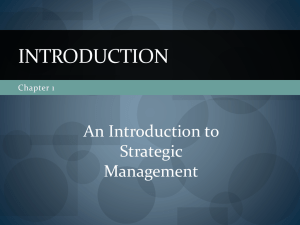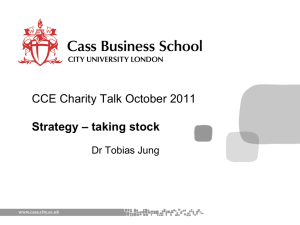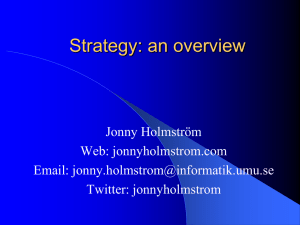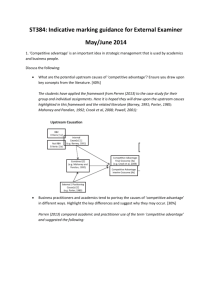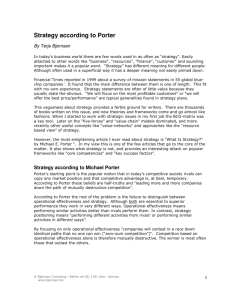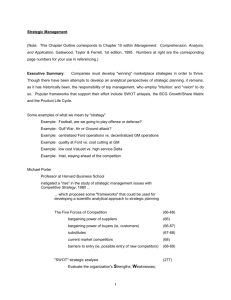Mintzberg's Refreshing View of Leadership
advertisement
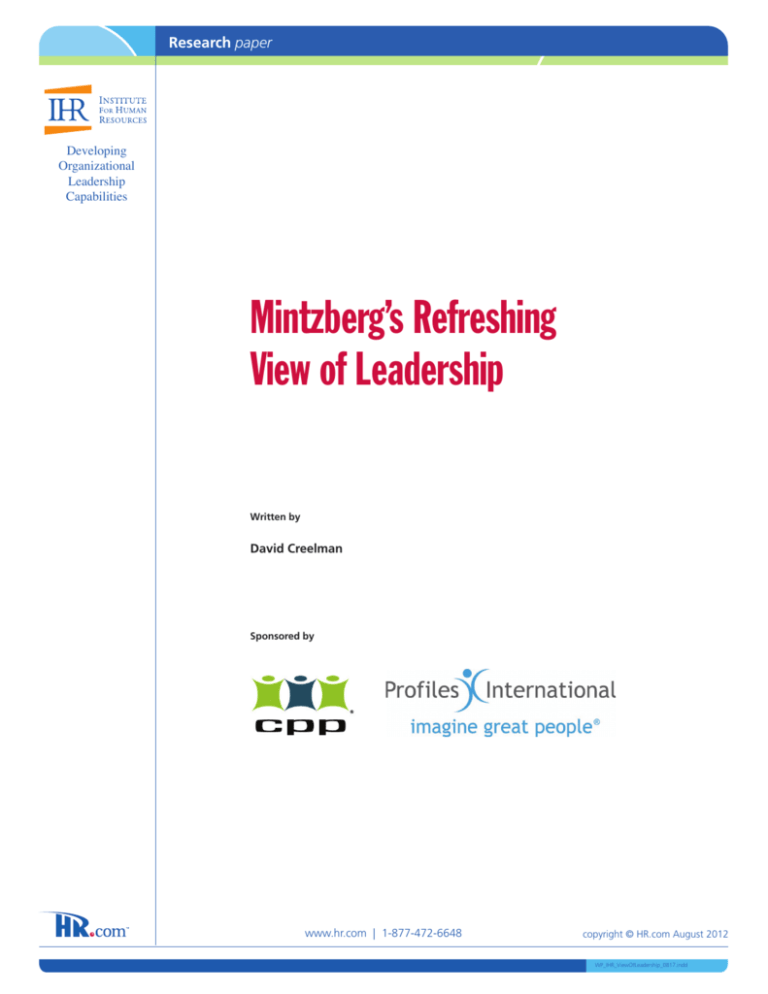
Research paper Developing Organizational Leadership Capabilities Mintzberg’s Refreshing View of Leadership Written by David Creelman Sponsored by www.hr.com | 1-877-472-6648 copyright © HR.com August 2012 WP_IHR_ViewOfLeadership_0817.indd Research paper Mintzberg’s Refreshing View of Leadership Developing Organizational Leadership Capabilities Most of what we read about leadership is inspirational. Is this a good thing? Might we benefit from a realistic view of leadership instead? The work of Dr. Henry Mintzberg provides a refreshing view of leaders as everyday people, not heroes. Mintzberg’s research has implications for how we select and develop leaders, and just as importantly dispels a mythic view of leadership that can get in our way. IHR Research Paper Rooted in Real Life Mintzberg’s secret is that his ideas are based on systematic observations of leaders. He first rose to prominence in 1973 when he published ‘The Nature of Managerial Work’. The book included the shocking finding that managers do not spend their days coolly planning, coordinating and controlling. Instead they were manically pulled from issue to issue, rarely spending more than a short time on any given task. Mintzberg says this insight was hardly brilliant; anyone who worked in an organization knew this was how managers worked. He was just the first person to write it down. How is it that so much literature on leadership implies their lives involve calmly planning, analyzing and making strategic decisions? It is because people write about their imagined view of what management should be, rather than observing what it is. People with an engineering bent envision leadership as a kind of engineering exercise involving plenty of analysis. A more romantic view sees leaders as extraordinary individuals who inspire. Mintzberg’s studies show that while there is both science and art in management, it is essentially a practice. You practice management like you practice medicine; medicine involves thinking, but also emphasizes hands-on involvement in getting things done. It is the same for a manager, not with scalpels, but with conversations. Mintzberg writes: “The manager does not leave the telephone, the meeting or the email to get back to work. These contacts are the work.”1 Leaders Versus Managers Readers may have noticed that in this paper the words ‘manager’ and ‘leader’ are interchangeable without making a distinction between them. Warren Bennis, a renowned management professor, convinced a lot of people that there is a huge gap between mere managers and lofty leaders. There is a kernel of value in this distinction. A manager with no hint of leadership would be a tedious boss. But a leader who does not manage is even worse. Mintzberg argues that leadership and management need to fit together in one role. Bennis, perhaps unintentionally, was appealing to an unrealistic view of superhuman leaders and that is where the harm lies. An organization needs managers who can lead, not a class of remote leaders overseeing unimaginative managers. A Model of Managing If leaders are managers and vice versa, what are the components of the role? Mintzberg wraps it up neatly in Figure 1 below. There are three ‘planes’ of work: information, people and action. Within each plane the focus may be into the unit, into the rest of the organization or outside the organization. 1 All quotes are from Mintzberg, Henry. Managing. San Francisco: Berrett-Koehler, 2009 www.hr.com | 1-877-472-6648 copyright © HR.com August 2012 2 Research paper Mintzberg’s Refreshing View of Leadership IHR Research Paper Developing Organizational Leadership Capabilities Figure 1: Mintzberg’s Model of Managing The model provokes the image of someone juggling three different types of balls for three different audiences—or else a puppet pulled in nine directions at once. That is indeed the role of a leader; part juggler, part puppet and without doubt in the center of organizational work. We may despair that managers spend so much time fighting fires rather than preventing them, but a look at the competing demands implied in the model shows that fighting fires is an inevitable part of the job. Mintzberg is fond of collecting lists of traits that good leaders are supposed to have. Combine a few of these lists and you quickly realize that it is a completely unrealistic list of demands. Looking back at the model in Figure 1, it is no surprise we have a hard time finding people who are intelligent with information, pragmatic with people and adept at action. Mintzberg contends that all real managers are flawed and that’s okay. Rather than seeing leadership as a rarefied quality found in a few individuals, we can see management as an everyday practice performed by imperfect humans who have been selected and developed to do a reasonably good job at this difficult role. Conundrums of a Difficult Role If we think management is mainly about solving problems then we may be misrepresenting the nature of the role. Many of situations managers face have no real solutions; they are conundrums to be managed. For example, a leader has to act with confidence even when they are far from certain that they have chosen the best course of action. Mintzberg writes: “…managers often have to feign confidence. For reasonably modest managers, this can be difficult enough; for the supremely confident, it may not be difficult at all, just catastrophic.” Another conundrum is the syndrome of superficiality. Managers want to do their work well, whether it is hiring a new worker, making a pitch to top management or doing a performance review. But how do you do it well when there is so much work to get done? There is no solution to that, simply an eternal tension to be managed. www.hr.com | 1-877-472-6648 copyright © HR.com August 2012 3 Research paper Mintzberg’s Refreshing View of Leadership Developing Organizational Leadership Capabilities Mintzberg also points out that while we forever tell managers they must delegate, “How do you delegate when so much of the relevant information is personal, oral and often privileged?” As one thinks of more conundrums they tend to blend together into our picture of the juggler or puppet, rushing from thing to thing, sometimes dropping a ball and yet somehow able, for the most part, to keep the demands balanced and get the work done. IHR Research Paper Implications for Human Resources Mintzberg’s work does not leave the reader all pumped up about leadership. If someone needs inspiration, a Disney movie will serve them better. For Mintzberg, leadership is a job that is done by everyday people, not just an extraordinary few. It takes some natural aptitude and it takes a good deal of experience, yet the idea that it is normal work done by normal people is a refreshing one. There are some clear implications for organizations and HR leaders. • Stop waiting for a savior. If we believe in superhuman leaders, then we seek them out as a solution rather than do the more mundane work of building good structures, effective processes, and high involvement management practices. • Focus on fit. Handling the competing conundrums of management requires lots of knowledge of the situation, strong relationships and a certain amount of good fortune that the person’s skills match the demands of the job at that point in time. A manager who does brilliantly in one place may founder in a different management role. Do not just think in terms of ‘A players’ but people who will be ‘A players’ in that particular role at that particular time. • Relieve some of the pressure on managers. Women will be familiar with the supermom ideal which suggests that women should be outstanding mothers, successful career women, and valued members of the communities all at the same time. This ideal may be inspiring, but is damaging to women who can never live up to this fantasy. Similarly, expecting managers to be super leaders creates harmful stress. Let’s accept that managers will have flaws. • Leadership selection. Mintzberg is skeptical of our ability to pluck out brilliant leaders by recruiting at the best schools. He argues that the best way to know if someone has aptitude for leadership is to observe them at work. Growing your own talent is the best way to develop leaders who know your business, your people and who fit your particular needs. • Leadership development. Mintzberg believes the best way to develop leaders is to have them reflect on their own experience with the help of conceptual models. The essence of this is simply giving managers some time to get away for an hour and have a conversation about management ideas and how those ideas shed light on their own experience. Leadership development expert Dr. Nancy Nazer points out that the idealized version of leadership (which Mintzberg critiques) leads us to seek out transformational leadership courses. These are almost always disappointing. Our managers may learn something, but they come out of the program the same flawed, normal people they were when they went in. A patient, incremental approach to leadership development will be more successful than one aimed at creating hero leaders. www.hr.com | 1-877-472-6648 copyright © HR.com August 2012 4 Research paper Mintzberg’s Refreshing View of Leadership When we started separating out the idea of leadership from management and putting inspirational hero leaders on a pedestal, we were moving away from the real world to a world of fantasy. We should not be dismissive of the value of dreams, yet the bulk of our business practices should be based on a solid understanding of how management is actually practiced. Mintzberg’s model keeps us grounded, which can be quite a relief. Leadership is a crazy job, but it is one that we can manage to get reasonably right more often than not. IHR Research Paper Developing Organizational Leadership Capabilities www.hr.com | 1-877-472-6648 copyright © HR.com August 2012 5
